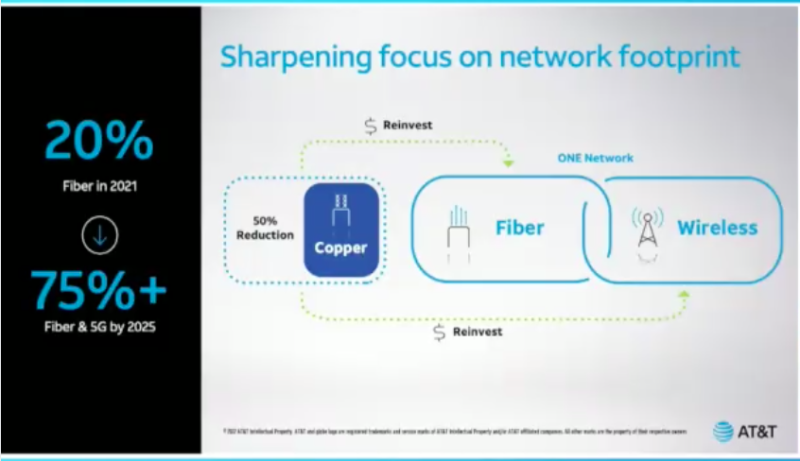AT&T executives outlined a network evolution at the carrier’s 2022 Analyst & Investor Day, explaining the foundational role fiber will play in supporting both its 5G network and its plans to boost returns while controlling capex.
CEO John Stankey told investors the carrier anticipates a fivefold increase in data on its network within the next five years. The company plans to support most of this traffic with fiber and to use its 5G network for high value mobile data.
Stankey said the drivers of this ballooning data demand include social media, gaming, telemedicine and business collaboration tools that move traffic “off corporate LANS and onto distributed WANS.”
“Will we get paid for this new world?” Stankey asked his audience rhetorically. He said history has shown that connectivity returns remain competitive as technology advances, and he predicted AT&T’s “cost of goods sold for connectivity will be comparatively small.”
“I worry less about getting paid and more about getting there fast enough,” Stankey summarized.
Getting there fast enough
Stankey said AT&T is currently “investing at record discretionary levels.” Priorities include growing the fiber footprint and deploying 5G infrastructure.
In a press release, AT&T forecast 2022 capex will be $24 billion, and stated 2023 capex will be “similar to 2022 levels and then to begin to taper to the $20 billion range starting in 2024.”
By 2025, AT&T expects 75% of its network footprint to be served via fiber and 5G. The company aims to reduce its copper services footprint by 50% by 2025.
“The reality is the curve is moving away from the scalability of wireless,” said Stankey. “Nothing is going to top fiber.”

5G follows fiber
Jenifer Robertson, EVP and GM, AT&T Mobility, told the audience AT&T’s wireless market share is 50% higher within its fiber footprint. “Where fiber goes, wireless follows,” she said, adding AT&T has the opportunity to sell wireless to four million residential fiber customers who don’t currently subscribe to its wireless network.
AT&T has 31% penetration across its fiber footprint, Robertson said, adding the company is not satisfied with this. “We’ve put down a marker. Everywhere we have fiber, we intend to own the home it’s connected to,” she said.
Later in the presentation, executives shared details about AT&T’s midband 5G buildout, repeating a previously stated goal of covering 70 million Americans with C-Band spectrum by year-end. They said each deployment will add a full 80 MHz of spectrum to the site, and described progress with the Federal Aviation Administration as “fabulous.”
Executives also noted AT&T’s wireless network now covers 2.9 million square miles, making it “America’s largest wireless network.”
Cloud migration
AT&T said the migration of its core network to the Microsoft cloud is well underway, with 1,500 applications moved so far. Executives noted the process is forcing harmonization of applications, making it easier for product and platform teams to efficiently code enhancements going forward.
Jeff McElfresh, CEO AT&T Communications, said AT&T’s enterprise customers are also moving operations to the cloud, adding that multi-cloud architectures are boosting bandwidth requirements, a demand which AT&T will address with both fiber and wireless.
“We want to manage traffic on the most cost-efficient technology,” McElfresh said. “We are not attempting to process terabytes of monthly consumption over wireless.”
Federal subsidies, FirstNet model
Stankey highlighted the importance of the Infrastructure Investment and Jobs Act and the Affordable Connectivity Program to AT&T. He said the company has not included revenue from these in its financial guidance yet, but has already won some new business through these programs.
The CEO also said AT&T is “working with policy makers to design programs” to make it easier for customers to access these federal subsidies.
During the presentations, Stankey’s team repeatedly referenced FirstNet as a business model AT&T wants to replicate by creating a dedicated organization to focus on the needs of a specific vertical market. Executives said AT&T wants to address manufacturing and healthcare with dedicated resources.
